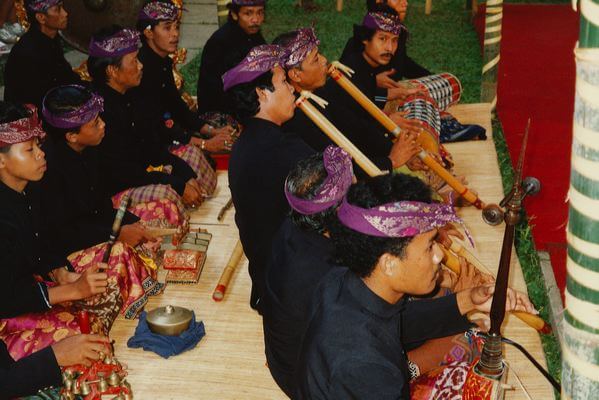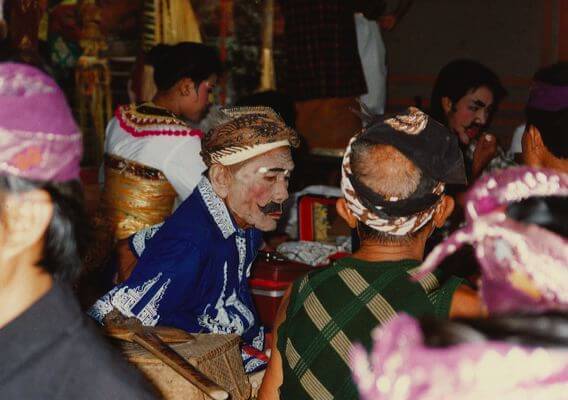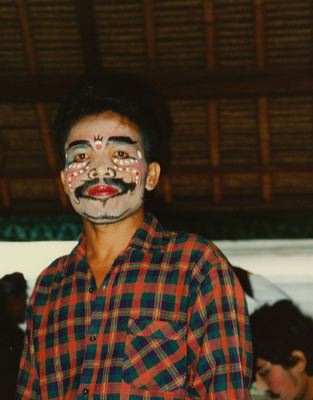Wayang Kulit and Gambuh, The East Javanese Heritage
Two genres of theatre survive in Bali: the wayang kulit shadow theatre and the gambuh court dance-drama, which have preserved the ancient Hindu-Javanese tradition in a possibly more archaic form than any corresponding form of theatre in Java. Between the ninth and the sixteenth centuries Bali had close contacts with East Java, at times belligerent and at times peaceful. Over these centuries, Bali adopted the Hindu-Buddhist court culture of East Java and its various forms of theatre.
Wayang Kulit, The Shadow Theatre
- Dalang, a Balinese wayang kulit narrator-puppeteer Jukka O. Miettinen
The Balinese wayang kulit is closely related to Javanese shadow theatre. This is indicated by the use of the name wayang kulit (wayang: shadow, puppet; kulit: leather) on both islands. Shadow theatre is believed to have arrived in Bali from Java along with the Indian-influenced court culture before the eleventh century. At this time the Balinese adopted the Ramayana and Mahabharata epics of India, which constitute the main repertoire of shadow theatre in both Java and Bali.
- Wayang kulit screen Jukka O. Miettinen
The Balinese and Javanese leather puppets are skilfully cut and incised, and they share common aesthetic principles: the puppet’s face and feet are shown in profile while the torso is presented frontally. The arms, articulated at the shoulder and the elbow, are the only jointed parts. Javanese and Balinese puppets differ, however, in style. Experts assume that the Javanese puppets received their extreme stylisation and symbolic character from the Islamic courts after the fall of the Majapahit Empire. The Balinese puppets, on the other hand, reflect older prototypes.
- East Javanese wayang style relief Jukka O. Miettinen
This is shown by the fact that the puppets of Bali with their headdresses, hairstyles, costumes, and their more realistic features reflect the stylisation and aesthetics of the low-relief carvings of the Majapahit temples in East Java. This archaic puppet style was preserved in Bali when contacts with Islamic Java ceased after the sixteenth century.
In Java wayang kulit developed into a large-scale, classical form of theatre of complex philosophical and aesthetic content, which had a decisive effect on the visual arts and other forms of theatre. In Bali shadow theatre also retained its ritual character and its role as a mediator of moral values, but it did not influence other forms of theatre to the same extent as in Java. However, the traditional Balinese style of painting, the so-called wayang style, is based on the stylization of the wayang puppets.
- The life-of-three motif of wayang kulit Jukka O. Miettinen
- A god with a mythical weapon Jukka O. Miettinen
- The barong stories were adapted to the wayang repertoire in the 20th century Jukka O. Miettinen
The primus motor of wayang kulit is the dalang who manipulates the puppets and acts as a narrator. He must have command of a wide range of vocal expression and the movement patterns of various puppets in addition to being responsible for the sacrifices and rituals connected with the performances. The art of puppetry is recorded in an old manual, called Dharma Pewayangan or the Laws of Puppetry.
Wayang kulit can be performed both in the daytime and at night. The night performances are literally a theatre of shadows, as the dalang moves the puppets behind a screen that is lit, while a screen is not used in the daytime form (wayang lemah). The Balinese wayang kulit does not require as large a troupe as its Javanese counterpart, and the former normally consists of the dalang and his assistants, and a small gamelan ensemble, usually with four metallophones.
The stories are derived not only from the originally Indian Ramayana and Mababharata epics but also from East Javanese story cycles, such as The Adventures of Prince Panji, known as Malat in Bali, and in the 20th century also the Calonarang, which deals with magical powers and horrible witches.
As in most other classical forms of Balinese theatre, the majority of the characters speak Kawi, the language of the Javanese courts from the tenth to the fifteenth century. The servant clown characters speak colloquial Balinese, translating the dialogue for an audience unfamiliar with Kawi. A wayang performance is a highly diverse combination of moral teachings, adventure, and slapstick and obscene burnout performed by the clowns, much loved by the Balinese. Wayang kulit is still popular, and several hundred dalang are active in Bali.
Gambuh
Gambuh (gam: way of life; buh: king) is an old form of court dance-drama. It has not been possible to trace its exact roots, or to define which specific Javanese traditions constitute its origins. It is believed, however, that this genre came from the royal courts of East Java. The gambuh tradition is at least four hundred years old, and it has had a great influence on other forms of theatre in Bali and Balinese dance in general. Gambuh is performed in the daytime, and it belongs to the semi-sacred bebali performances. While originally performed at court festivities, it can be seen at present in temples and in commercial performances, although the latter are very rare.
- The rather small orchestra of gambuh is dominated by long bamboo flutes Kimmo Kahra
The gambuh repertoire is drawn from classical epic literature, usually East Javanese tales relating to Prince Panji. As in the wayang kulit, several languages are used with the royal characters speaking Kawi, the old Javanese court language, and the comic servant characters conversing in colloquial Balinese. The musical accompaniment is extremely complex and perhaps the most demanding form of Balinese music.
- Preparing for the gambuh performance Kimmo Kahra
The orchestra is relatively small and dominated by long, wailing flutes. Gambuh was originally performed by an all-male cast, but today women usually play female roles and sometimes even noble heroic characters. The all-male gambuh was, however, revived at the end of the 20th century with great success. Experiments have also been done with Western texts, such as Shakespeare’s Macbeth in 1990.
- Gambuh make-up Kimmo Kahra
Like most South-East Asian theatre traditions, gambuh has distinct stock characters with specific styles of dance, make-up, and costume. The characters correspond to the Indonesian classification according to which heroes are represented in refined (alus) and sweet (manis) styles. Ministers, attendants, and evil figures are portrayed in strong (keras) and coarse (kasar) styles.
- Opening dance of a gambuh performance Kimmo Kahra
The general dance style of gambuh is characterised by stiff shoulders, tensely moving arms and expressive, upwardly bent movements of the fingers. In the basic position, the thighs and knees are turned outwards, with the legs forming a kind of rhombus, and the shoulders are pulled up so that the head rests on the torso. The dancer often lowers his centre of gravity in a kind of demi plié by bending the legs and shifting his weight from one leg to the other.
The hands repeat the conventional gestures, echoing the distant influence of the mudra, the symbolic hand gestures of Indian dance. In fact, the Sanskrit term mudra is still used in Balinese to denote a gesture. The facial expression is also dictated by convention, but expressive eye movements are used considerably more than in Javanese dance.
This dance technique can well be described as the Balinese classical style, for it has been adapted in the techniques of other major genres such as the legong, topeng, and arja. The court performances originally went on for days, but a modern-day gambuh performance lasts only a few hours.
It is composed of stock scenes, where fixed characters present monologues, dialogues, dances typical of their roles, and sometimes fighting scenes. Traditionally, sets or props are not used. The performing area, usually a second temple courtyard in the gambuh as well as in other bebali performances, is fitted with traditional parasols and bamboo decorations, with the costumes, based on old court dress, providing additional visual splendour.
A typical gambuh costume consists of a long-legged and long-sleeved white undergarment and a wide, gold-embroidered collar with wide gold-patterned strips of fabric hanging down to the knees. The actors move the strips in the same delicate way as the Javanese court dancers handle their long scarves. The costume includes an impressive piece of headgear, often decorated with fresh flowers. Like the dance technique of the gambuh, the costume was also adopted by other theatre traditions.
The present repertoire represents only a small fraction of the original gambuh tradition. When the Dutch conquered the Balinese courts in the early twentieth century, the gambuh lost its original royal patronage. In its extreme sophistication, it could not survive as such in the village communities. Performances were shortened and the style was vulgarised, but despite these developments the gambuh is still being performed.









